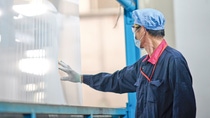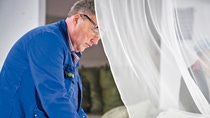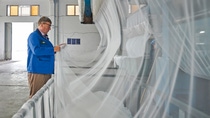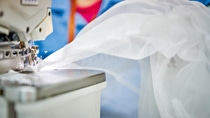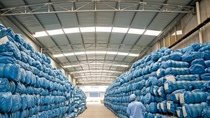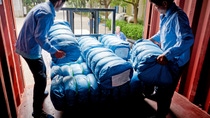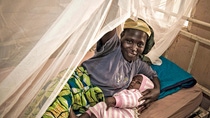Agriculture
Manufacturing A New Generation Of Mosquito Net
The Interceptor® G2 mosquito net has been hailed by public health experts as a significant scientific breakthrough to combat malaria in areas where insecticide-resistant mosquitoes are causing cases to rise. So how is the scale-up of the new nets going?
In Fall 2019, BASF scientist and public health expert, Dr Volker Frenz went to China to check on the first major order - two million Interceptor G2 mosquito nets for Burkina Faso.
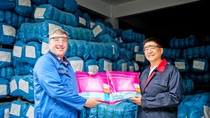
Dr Frenz, what’s your role in the production of the Interceptor G2 nets?
Frenz: I lead BASF’s Public Health development laboratory and am responsible for transferring Interceptor G2 from the lab into production, as well as for production trials and quality management.
What was the reason for your visit to China?
Frenz: I was there to support the final production phase of the first two million Interceptor G2 nets for The New Nets Project in Burkina Faso, a malaria-endemic country severely affected by insecticide resistance. Treated bed nets have prevented more than 450 million malaria cases in Africa, but progress is now stalling and that’s why these new tools are so urgently needed.
Why is Interceptor G2 so special?
Frenz: Unlike conventional mosquito nets, Interceptor G2 uses a combination of two different insecticides. It’s one of the few mosquito nets currently available to combat resistant mosquitoes. The insecticides have different molecular structures, so it was a long process to develop a coating that would be safe and long-lasting, would stick to the outside of the fibers, and be effective against malaria-carrying mosquitoes. The Interceptor G2 net is patented and it took years of development and testing in the lab and the factory to get everything exactly right.
Does BASF produce the nets in-house?
Frenz: BASF has a long heritage of expertise in textile dyes and chemicals, but we do not have textile manufacturing facilities. Interceptor G2 nets are manufactured under ISO9001:2015 standards by specialist textile companies in Eastern China and Thailand. They have been trusted BASF partners for more than 10 years and have been very important in helping us to scale-up production of these new nets.
How Interceptor® G2 mosquito nets are produced
How are the new nets actually made?
Frenz: The Interceptor G2 nets are produced in two major steps. First, the untreated netting undergoes a textile process to coat it with a combination of the insecticides and a binder system. Then the coated netting is cut and sewn by hand into either square or bell-shaped mosquito nets. Once the quality assurance team has checked each batch to make sure there are no holes, stains or bad seams and the nets are labelled, the finished nets are packed, sealed and stored in bales of typically 50 nets until they are ready for shipping.
Is it safe for the people making the nets? Why are they wearing protective equipment?
Frenz: Yes, it is safe for the employees to make the nets and they all have regular health checks. Interceptor G2 is now WHO PQ listed, which indicates that it has been evaluated for quality, efficacy and safety. Interceptor G2 nets were found to be safe for use by adults, children and babies to combat malaria. However, over time in a commercial production process where employees are cutting, sewing and working continuously every day with large quantities of the polyester netting, fine dust particles may cause skin irritation. The employees wear protective masks and gloves as a preventative measure against this. I like to explain it by comparing it to a hairdresser: if you wash and style your hair once a day, it is very unlikely that you will experience any problems. But for hairdressers who are using hair products all day, there can be a risk of skin irritation over time and that’s why they also wear protective gloves.
Users who touch the net only for short periods of time are not required to wear masks or gloves. Nevertheless, we do recommend that the nets are rinsed with water before first use to avoid possible skin irritation caused by dust particles from production.
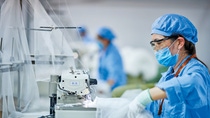
Since your visit, China has been severely affected by the outbreak of the COVID-19 crisis. How did this impact production of the new nets?
Frenz: It has been quite a challenging time for the team in China, but the most important thing, and something that we are very happy to say, is that all the employees are safe and well. The company closed during the crisis according to the Chinese government regulations but was able to reopen again when the restrictions were lifted. Social distancing is still in force, and some employees had initial difficulties with travel, but despite the challenges, everyone is doing a great job to re-start and ramp-up production of Interceptor G2 to fulfill our deliveries to Africa and help to save lives again.
More About Interceptor® G2
In 2017, the World Health Organization (WHO) awarded Interceptor G2, a new generation of insecticide-treated mosquito nets, an interim recommendation for malaria control, the first for a product based on a new insecticide class in more than 30 years. Country registrations started as well as a scale-up into commercial production. In 2018, The New Nets Project launched a large pilot to deliver Interceptor G2 to regions where they are most needed and generate data on their public health value. In 2019, BASF announced a major collaboration with MedAccess and the Bill & Melinda Gates Foundation to supply 35 million nets to malaria-endemic countries. Both collaborations have been very successful and almost 10 million Interceptor G2 nets have already been delivered to Africa. In parallel, a large-scale trial is ongoing as part of the full WHO recommendation process with results expected in 2022.
